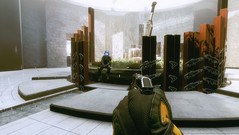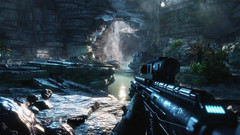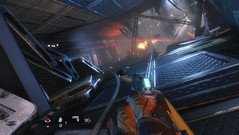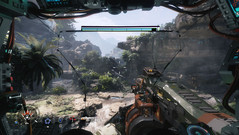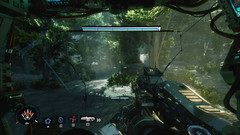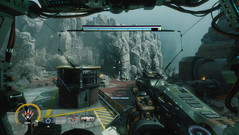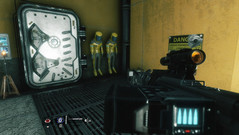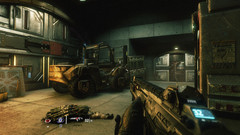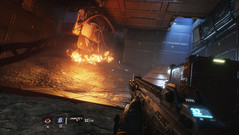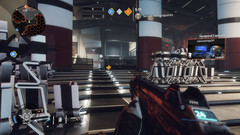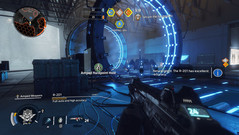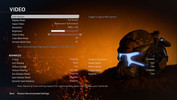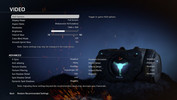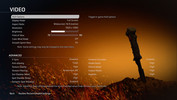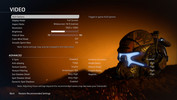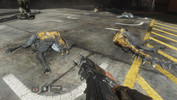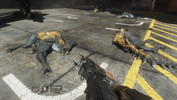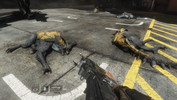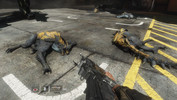Titanfall 2 Notebook and Desktop Benchmarks
For the original German article, see here.
Titanfall 2's Gaming Environment
After a notable effort early in 2014, when game developer Respawn Entertainment hooked up with game publisher Electronic Arts (EA) to create Titanfall 1, this same team now seeks to up its game, not just with multiplayer mode but also with a genuine in-game military campaign. However, it may not be smart to expect too much from their latest efforts. Although the game trailer and tutorial are pretty slick and whet players’ appetites for the real thing, working through the nine missions that make up “Titanfall 2” quickly becomes too monotonous.
As in most first-person shooters, the game puts more emphasis on barrelling through your opponents than the story campaign. Assignments are mostly standard (get to Point X, find object Y, and push button Z). However, in keeping with the now-familiar theme of robotic assistants or alter egos, as told in hit movies like Pacific Rim, Avatar, and Transformers, and in preparing for multiplayer roles, the in-game campaigns are convincing and engaging.
The incredibly fluid game play in Titanfall 2 is what really works best. Thanks to the built-in navigation, many possible moves (such as running on the walls or ceiling, double jumps, and so forth) and slick animation, we felt immersed in a Parkour world reminiscent of “Mirror's Edge Catalyst” or “Assassin's Creed Syndicate”. In other words: hardly any FPS games play as fluidly, with as many interesting available variants. But despite its support for complex movement, “Titanfall 2” is more like “Call of Duty” than “Battlefield”, in that it puts more emphasis on tactics and serious military manoeuvres. The game lends itself to fast, well-thought-out action. It also emphasizes casual play and multi-faceted upgrade trends (players can select and tweak in-game options to their hearts’ content).
As far as in-game graphics are concerned, they are both decent and stable. “Titanfall 2” uses the heavily improved version of the Source engine, which we have already seen in countless Valve games (such as “Dota 2”, “Counter-Strike GO”, “Portal 2” and "Left 4 Dead 2”). Texturing stays sharp over large surfaces, though you will encounter Moiré patterning or aliasing in some scenes here and there. On the plus side, more detailed renderings – in game avatars and their robots - remain crisp and recognizable throughout gameplay.
The lighting and shading system creates contradictory impressions. Although interior scenes are nicely lit with notable atmospheric touches, outdoor scenes come across as overly bright (“Watch Dogs” comes to mind in this connection). Anti-aliasing is turned on by default in the game, and gives it a cinema like quality, but also poses similar contradictions. Assessing all of its graphics capabilities as a whole, “Titanfall 2” manages to look quite appealing, even though it is not likely to challenge Frostbite-3 based games (such as “Battlefield 1”) any time soon.
PC users will be satisfied with the at-a-glance video menu. Its top half lets players arrange a heads-up display, manage image display and resolution, control brightness and select a specific field of view. The Advanced menu lets users manage graphics quality, toggle vertical synchronization, and change edge smoothing settings. “Titanfall 2” also supports controls for various levels of TSAA, MSAA and/or CSAA. Overall, it is obvious that anti-aliasing is improving the graphics quality as can be seen when looking at sharp edges rendered in the game (see the stairs and ventilation grilles in the comparison screen captures below).
Most graphics options are usable during game play. We were less thrilled to learn that the game comes without pre-sets or pre-defined configurations that would support simple 1-click tuning (a common and essential feature in many modern PC games). But at least the game supports per-setting text descriptions, so that beginners are not left completely in the cold.
If you dig deeply into the finer details of the graphics (missing shadows, blurry textures, and so forth) “Titanfall 2” does not fall behind the competition in the FPS genre. Mid-level details in the game are rendered well, and look good at high graphics settings. For some features, even the challenging Very High setting is tolerable (Insane @Texture Quality). Subjectively, we could not see much room for improvement. From a more technical perspective, the game comes across as well-executed. We did not have to deal with crashing or major graphic errors while running this game (with a minor exception for Intel GPUs, never terribly adroit at real-time handling of all but the most modest graphics settings of any kind).
As far as multi-player mode goes – as far as we can tell after a handful of such matches – graphics and gameplay are likewise stable. Load times and installation size (~37 GB to launch the game) are average for a 2016-vintage FPS. Performance junkie warning: “Titanfall 2” limits frame rates to 144 FPS (something that only the most capable systems can deliver anyway). The developers could also have done a better job in terms of display recognition. Several of our test systems could not deliver their highest resolutions on the first try. We had to either reboot those systems, or change the graphics scaling, to solve those problems. After such fiddling about, though, everything worked reasonably well.
Benchmark
For our performance analysis, we focused on the beginning segment of the fourth Mission in the “Titanfall 2” campaign, entitled “Into the Abyss.” After the main character starts walking for a few seconds, there is a stylish transition to the robot figure, which just happens to be named “Titan.” In the final half minute of this segment there is a dimly lit walk down a water-logged path surround by cliffs on both sides.
During the course of our testing this sequence ran at about the expected average frame rate, whether in single or multiplayer mode (for the sake of comparison, we double-checked both maps in Amped-Hardpoint mode, just to make sure). To accommodate heavy, heated action with other players and leave headroom for cool manoeuvres, we decided the average frame rate should not dip below 40 FPS.
Results
The hardware settings in “Titanfall 2” are directly comparable to those in “Battlefield 1”. Office and capable multimedia systems with built-in graphics (such as Intel's HD Graphics 4600) or a dedicated low-end GPU (such as a GeForce GT 720M) will experience difficulties rendering fluid motion on-screen, even at minimum detail settings and 1280x720 pixel resolution. For these settings, and also for 1366x768 plus normal detail settings, a mid-range model in the order of a GeForce 940M is really needed.
For resolutions in the full HD range (1920x1080 or thereabouts) a gaming-oriented GPU is called for. The combination of FHD and Medium demands a GPU such as the GeForce GTX 860M, while FHD and High need something like the GeForce GTX 870M. Maximum settings will not run completely smoothly with anything short of a GeForce GTX 880M or GeForce GTX 965M.
For 3840x2160 resolution, aka 4K or UHD, a top-of-the-line GPU must be available. The GeForce GTX 1070 is about as low as one dare go here. That said, the CPU has very little influence on the frame rate, as long as it is fairly modern (Haswell vintage or newer). Limits on gameplay almost always depend on graphics capabilities.
| Titanfall 2 | |
| 3840x2160 High / Enabled AA:TS AF:8x 1920x1080 Very High (Insane Texture Quality) / Enabled AA:TS AF:16x 1920x1080 High / Enabled AA:TS AF:8x 1920x1080 Medium / Disabled AF:4x 1366x768 Medium / Disabled AF:4x 1280x720 Low / Disabled AF:Trilinear | |
| NVIDIA GeForce GTX 1080 (Desktop), 4790K | |
| NVIDIA GeForce GTX 1080 (Desktop), 4790K | |
| NVIDIA GeForce GTX 1070 (Desktop), 4790K | |
| NVIDIA GeForce GTX 1070 Mobile, 6820HK | |
| NVIDIA GeForce GTX 980 Ti, 4790K | |
| AMD Radeon R9 Fury, 4790K | |
| NVIDIA GeForce GTX 980, 6700K | |
| NVIDIA GeForce GTX 1060 (Desktop), 6700K | |
| AMD Radeon RX 480 (Desktop), 4790K | |
| NVIDIA GeForce GTX 970, 4790K | |
| AMD Radeon RX 470 (Desktop), 4790K | |
| AMD Radeon R9 290X, 4790K | |
| NVIDIA GeForce GTX 980M, 4700MQ | |
| NVIDIA GeForce GTX 970M, 4700MQ | |
| NVIDIA GeForce GTX 880M, 4700MQ | |
| AMD Radeon R7 370, 4790K | |
| AMD Radeon RX 460 (Desktop), 4790K | |
| NVIDIA GeForce GTX 965M, 6700HQ | |
| NVIDIA GeForce GTX 870M, 4700MQ | |
| NVIDIA GeForce GTX 960M, 4720HQ | |
| NVIDIA GeForce GTX 860M, 4700MQ | |
| NVIDIA GeForce GTX 950M, 6700HQ | |
| NVIDIA GeForce 940MX, 6700HQ | |
| NVIDIA GeForce 940M, 5700HQ | |
| NVIDIA GeForce GT 720M, 4200M | |
| Intel HD Graphics 4600, 4700MQ | |
Overview
Test System
| Desktop-PCs | Platform I | Platform II |
|---|---|---|
| Mainboard | Asus Z170-A | Asus Z97-Deluxe |
| Processor | Intel Core i7-6700K (Skylake) | Intel Core i7-4790K (Haswell) |
| Graphics card | Nvidia GeForce GTX 1060 (6 GB GDDR5) Nvidia GeForce GTX 980 (4 GB GDDR5) |
Nvidia GeForce GTX 1080 (8 GB GDDR5X) Asus GeForce GTX 980 Ti (6 GB GDDR5) XFX Radeon R9 Fury (4 GB HBM) Sapphire Radeon R9 290X (4 GB GDDR5) Sapphire Radeon R9 280X (3 GB GDDR5) MSI Radeon R7 370 (2 GB GDDR5) |
| RAM | 2 x 8 GB DDR4-2133 | 2 x 4 GB DDR3-1600 |
| Storage | Crucial MX100 SSD (256 GB) Crucial M500 SSD (480 GB) OCZ Trion 100 SSD (480 GB) OCZ Trion 150 SSD (960 GB) |
Intel SSD 530 (240 GB) OCZ Trion 100 SSD (480 GB) |
| OS | Windows 10 Pro 64 Bit | Windows 10 Home 64 Bit |
| Schenker Notebooks | Schenker W504 | Schenker XMG A505 | Schenker S413 |
|---|---|---|---|
| Mainboard | Intel HM87 | Intel HM87 | Intel HM87 |
| Processor | Intel Core i7-4700MQ (Haswell) | Intel Core i7-4720HQ (Haswell) | Intel Core i7-4750HQ (Haswell) |
| Graphics card | Nvidia GeForce GTX 980M (8 GB GDDR5) GTX 970M (6 GB GDDR5) GTX 880M (8 GB GDDR5) GTX 870M (6 GB GDDR5) GTX 860M Kepler (4 GB GDDR5) |
Nvidia GeForce GTX 960M (2 GB GDDR5) | Intel Iris Pro Graphics 5200 |
| RAM | 2x 4 GB DDR3-1600 | 2x 4 GB DDR3-1600 | 2x 8 GB DDR3-1600 |
| Storage | Samsung SSD 840 EVO (250 GB) | Micron M600 SSD (128 GB) HGST Travelstar 7K1000 HDD (1.000 GB) |
Intel SSD |
| OS | Windows 10 Pro 64 Bit | Windows 10 Home 64 Bit | Windows 10 Home 64 Bit |
| MSI Notebooks | MSI GE72 | MSI PE60 | MSI GP62 | MSI CX61 | MSI CX61 |
|---|---|---|---|---|---|
| Mainboard | Intel HM170 | Intel HM170 | Intel HM86 | Intel HM86 | Intel HM86 |
| Processor | Intel Core i7-6700HQ (Skylake) | Intel Core i7-6700HQ (Skylake) | Intel Core i7-5700HQ (Broadwell) | Intel Celeron 2970M (Haswell) | Intel Core i5-4200M (Haswell) |
| Graphics card | Nvidia GeForce GTX 965M 2016 (2 GB GDDR5) | Nvidia GeForce GTX 950M (2 GB GDDR5) | Nvidia GeForce 940M (2 GB DDR3) | Nvidia GeForce 920M (2 GB DDR3) | Nvidia GeForce GT 720M (2 GB DDR3) |
| RAM | 1x 8 GB DDR4-2133 | 2x 4 GB DDR4-2133 | 1x 8 GB DDR3-1600 | 1x 8 GB DDR3-1600 | 1x 8 GB DDR3-1600 |
| Storage | Toshiba THNSNJ128G8NU SSD (128 GB) WDC WD10JPVX HDD (1.000 GB) OCZ Trion 100 SSD (480 GB) |
Toshiba MQ01ABF050 HDD (500 GB) | WDC Scorpio Blue HDD (1.000 GB) | ||
| OS | Windows 10 Home 64 Bit | Windows 10 | Windows 10 | Windows 10 | Windows 7 Home Premium 64 Bit |
| Asus Notebooks | Asus G752VS | Asus N551ZU |
|---|---|---|
| Mainboard | Intel CM236 | AMD K15.1 |
| Processor | Intel Core i7-6820HK (Skylake) | AMD FX-7600P (Kaveri) |
| Graphics card | Nvidia GeForce GTX 1070 (8 GB GDDR5) | AMD Radeon R9 M280X (4 GB GDDR5) |
| RAM | 4x 16 GB DDR4-2400 | 2x 4 GB DDR3-1600 |
| Storage | Toshiba NVMe THNSN5512GPU7 SSD (512 GB) | Samsung SSD 830 (256 GB) |
| OS | Windows 10 Pro 64 Bit | Windows 10 64 Bit |
| 4K Monitor | Nvidia driver | AMD driver | Intel driver |
|---|---|---|---|
| 2x Asus PB287Q | ForceWare 375.70 | Crimson 16.10.3 | 15.40.28.4501 |







